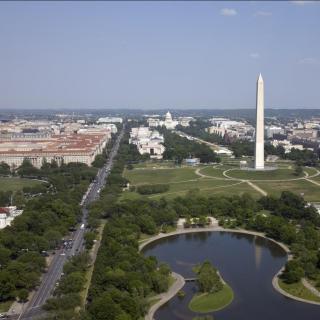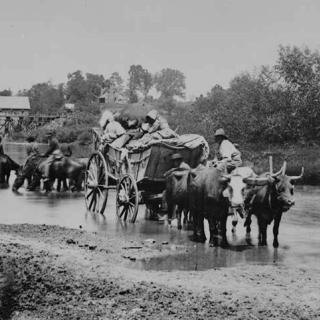Claiming a Neighborhood: Shaw and Little Ethiopia
Who can rightfully lay claim to a neighborhood? In an historic, but fast-changing city like Washington, that’s not always an easy question to answer. Case in point: Shaw.
In the mid 1990s, the traditionally African American neighborhood in Northwest Washington experienced a cultural collision of sorts when Ethiopian immigrants began to settle there en-masse and open up businesses. In the matter of a few short years, no less than 10 Ethiopian restaurants opened in the vicinity of Ninth and U Streets, NW.[1] The cluster became a draw for foodies in D.C.’s growing culinary scene and an economic boon for the District.
In 2005, Ethiopian restaurateurs started a campaign to have the city rename a strip of Ninth Street between U and T as “Little Ethiopia.” As community leader Tamrat Medhin explained, the campaign was a matter of boosting business and building awareness. “We’d like to get recognition from the host country for our contributions. There are thousands of people serving in taxis, parking lots, hotels, and restaurants. We are doing stuff.”[2] Dukem restaurant owner, Derege Zewdie, added that creating “Little Ethiopia” would “give the rest of the world a chance to know who Ethiopians are…. It will be on the map.”[3]
The restaurateurs found a friendly ear in city councilman Jim Graham, who told the Washington Post that the name would be “a fitting honorific designation of one community’s major contribution to the District of Columbia.”[4]
As Graham alluded, Ethiopians had been part of Washington’s cultural fabric for decades. Back in the ‘60s and ‘70s, middle and upper class immigrants were attracted to D.C. because of the educational and professional opportunities the city had to offer. Following the Derg, a militant insurgency which overthrew Ethiopia’s last emperor (Haile Selassie) in 1974 and brought in a Marxist regime, more immigrants of other socioeconomic stripes followed. After taking a brief pause, large-scale Ethiopian migration resumed after the ratification of the Refugee Act of 1980 and a horrific famine which ravaged Ethiopia from 1983 to 1985.[5]
Many of these immigrants assumed that their stay in the U.S. would be temporary. But as political and ecological turmoil began to engulf their homeland, that belief faded.[6] As Tsehaye Teferra, director of the Ethiopian Community Development Council in Alexandria, explained to the Washington Post in 1987, “Our attitude was, ‘we are going back home tomorrow.’ We were not interested in doing anything that would tie us down, like buying a house. Now people realize this is going to be home.’"[7]
In Washington, the newly-rooted community established the Ethiopian Orthodox Church and other organizations which helped new immigrants acclimate to American life while also holding onto their Ethiopian identity. This, in turn, encouraged more immigrants to settle in the Washington area, which had the largest concentration of Ethiopians outside of Africa by the mid-1990s.[8]
Yodit, an immigrant who settled in DC in the ‘90s elaborated on the comfort the community provided her:
“When we were thinking of starting a family, we knew it was important to be close to our people. We wanted our kids to be around people like them. To see Ethiopians, to have Ethiopian friends, to be part of family and community celebrations… I started my own business and it was hard work, but I think it’s paying off. I am glad to be around other Habashas and glad for my kids’ sake. We are not isolated anymore.”[9]
According to Peter Hagos Gebre, author of Making it in America, Ethiopians “made a huge contribution to reviving neighborhoods” in the District.[10] Following the entrepreneurial vanguard to economically depressed neighborhoods, they established communities around the restaurants and business they established. In the 1980s, that meant 18th Street in Adams Morgan. But, when rents began to go up in the mid 1990s, the community migrated to the U Street corridor and Shaw.[11]
As the Post noted in 2011, “In Washington, Ethiopians have been so successful in redeveloping retail strips that urban histories see their arrival in a neighborhood as a first sign of gentrification – way before the better known waves of hipsters and gay urban pioneers.”[12] Part of that success lay in the fact that the community took care of its own, through a money pooling arrangement called ekub, which spread wealth and allowed entrepreneurs to take risks.[13]
The eateries that sprouted up near the intersection of Ninth St. and U St. included U Turn, Queen Makeda, Dukem, and others. These establishments entertained people with music and made Ethiopians feel at home with food from their childhoods. Mesafint Beyene, a regular patron of the Queen Makeda restaurant said of the food, "Remember when your mother cooked for you at home? That's the taste you'll find here."[14]
When restaurateurs mounted their renaming campaign in 2005, they wished to recognize the at-home feeling that Mesafint and other Ethiopians felt, and solidify their claim on the neighborhood, which still showed the scars of the 1968 riots that ravaged Washington’s inner city. The designation was something the Ethiopian entrepreneurs felt they had earned, as Belay Sahlemariam, co-owner of the then-popular U-Turn, explained: “We bought abandoned buildings, rebuilt them and cleaned this area up to make it what it is.”[15]
Organizers of the renaming campaign worked in conjunction with the Ethiopian American Constituency Foundation to mobilize Ethiopian support for the initiative. To accomplish this task, the EACF created an online petition. The petition garnered thousands of signatures and, coupled with the support of Councilman Graham, it looked like the campaign was gaining real momentum.[16]
Not all were pleased with the proposal, however. Strong objections came from the African–American community, which had a historic connection to the U Street corridor and Shaw neighborhood. For decades before the riots, the area had been a cultural center for African Americans, as U Street earned the moniker “Black Broadway.”[17] Many, like retired postal worker Clyde Howard, felt that the Ethiopian newcomers had not yet paid their dues. As he explained to the Washington Post, "Where were they during the [1968] riots? They're Johnny-come-lately. What gives them the right? Just because you opened a store?"[18]
Deairich Hunter, chairman of the Advisory Neighborhood Commission of Shaw, argued that the Ethiopian community was not solely responsible for Shaw’s transformation. Commenting on the gentrification then taking hold in the neighborhood, he told the Post, “The reality is that it's predominantly whites and gays, but you don't hear these populations asking to change the name."[19]
The Ethiopian business owners behind the campaign pushed back. As Terfera Zewdie explained: “Show me where it says you need to be somewhere 12 years to have your own community. Things change…. Washington, D.C. is so big. We didn’t ask for U Street. We said Ninth Street. U Street doesn’t run all the way to the White House.”[20]
Ultimately, however, EACF’s renaming campaign failed. The city council did not push the initiative forward and Little Ethiopia signs were never raised.[21]
In the years since the failed campaign, the Ethiopian community’s profile in the Washington area has continued to grow, though its presence in Shaw has diminished. Just as their move into the Adams Morgan neighborhood decades ago preceded white migration and rising rents, soaring real estate values in Shaw have caused many to look elsewhere. In recent years, other jurisdictions including Alexandria, Silver Spring, Prince Georges, Loudon and Prince William counties have seen a significant uptick in Ethiopian population.[22]
One of those restaurateurs who decided to flee Shaw’s rising rents was Zenebech Dessu, who established her business in 1998. By 2016, she decided to sell the popular Zenebech Restaurant after her property taxes “increased tenfold.” Lamenting her move from Shaw, Dessu reflected on the aspects of D.C.’s Ethiopian community which made her, and others like her, feel welcomed to the city when she arrived as a political refugee in 1990; “I’m not happy, but I decided I had to sell it. With the three of us Ethiopian owners on this street, it feels like Ethiopia here.” She continued, “I know I’m going to miss talking outside, doing what I’m doing right now. I’ve had a family thing here.” Though uncertain of her future, Dessu was certain she would open another restaurant. She said, “I’ll open another place, but where, I don’t know yet.” If recent history is any indication, wherever Dessu and other Ethiopian restaurateurs decide to open their businesses, chances are they will bring the Ethiopian immigrant culture and will spur economic activity.[23]
Footnotes
- ^ Walter Nicholls, “Washington’s Little Ethiopia,” The Washington Post, May 18, 2005, http://www.washingtonpost.com/wp-dyn/content/article/2005/05/17/AR20050…
- ^ Paul Schwartzman, “Shaw Shuns ‘Little Ethiopia,’” The Washington Post, July 25, 2005, http://www.washingtonpost.com/wp-dyn/content/article/2005/07/24/AR20050….
- ^ Paul Schwartzman, “Shaw Shuns ‘Little Ethiopia,’” The Washington Post, July 25, 2005, http://www.washingtonpost.com/wp-dyn/content/article/2005/07/24/AR20050….
- ^ Ibid.
- ^ Elizabeth Chacko, “Africans in Washington, DC: Ethiopian Ethnic Institutions and Immigrant Adjustment,” in African Diaspora in the United States and Canada at the Dawn of the 21st Century, ed. John Frazier, Joe Darden, Norah Henry (Binghamton: World Academic Press, 2009), 245; Solomon Getahun, The History of Ethiopian Immigrants and Refugees in America: 1900-2000 Patterns of Migration, Survival, and Adjustment (New York: LFB Scholarly Publications, 2007), 44-48.
- ^ Ibid.
- ^ Marc Fisher, “Area Ethiopian Enclave Shares the Little it has: Close-Knit Ethiopian Refugees Have Intricate Support System for their Own,” The Washington Post, April 26, 1987, ProQuest Historical Newspapers: The Washington Post.
- ^ Elizabeth Chacko, “Translocality in Washington, D.C. and Addis Ababa: Spaces and Linkages of the Ethiopian Diaspora in Two Capital Cities,” in Translocal Geographies: Spaces, Places, Connections, ed. Katherine Brickell, Ayona Datta (Farnham, UK: Ashgate Publishing, 2011), 165.
- ^ Elizabeth Chacko, “Translocality in Washington, D.C. and Addis Ababa: Spaces and Linkages of the Ethiopian Diaspora in Two Capital Cities,” in Translocal Geographies: Spaces, Places, Connections, ed. Katherine Brickell, Ayona Datta (Farnham, UK: Ashgate Publishing, 2011), 165-166.
- ^ Emily Wax, “Ethiopian Yellow Pages: Life, by the Book,” The Washington Post, June 8, 2011, https://www.washingtonpost.com/lifestyle/style/ethiopian-yellow-pages-l….
- ^ Walter Nicholls, “Washington’s Little Ethiopia,” The Washington Post, May 18, 2005, http://www.washingtonpost.com/wp-dyn/content/article/2005/05/17/AR20050….
- ^ Emily Wax, “Ethiopian Yellow Pages: Life, by the Book,” The Washington Post, June 8, 2011, https://www.washingtonpost.com/lifestyle/style/ethiopian-yellow-pages-l…
- ^ Elizabeth Chacko, “Africans in Washington, DC: Ethiopian Ethnic Institutions and Immigrant Adjustment,” in African Diaspora in the United States and Canada at the Dawn of the 21st Century, ed. John Frazier, Joe Darden, Norah Henry (Binghamton: World Academic Press, 2009), 246-247.
- ^ Walter Nicholls, “Washington’s Little Ethiopia,” The Washington Post, May 18, 2005, http://www.washingtonpost.com/wp-dyn/content/article/2005/05/17/AR20050….
- ^ Ibid.
- ^ Elizabeth Chacko, “Translocality in Washington, D.C. and Addis Ababa: Spaces and Linkages of the Ethiopian Diaspora in Two Capital Cities,” in Translocal Geographies: Spaces, Places, Connections, ed. Katherine Brickell, Ayona Datta (Farnham, UK: Ashgate Publishing, 2011), 170.
- ^ Trymaine Lee, “As Black Population Declines in Washington D.C., Little Ethiopia Thrives,” The Huffington Post, June 8, 2011, https://www.huffingtonpost.com/2011/04/08/black-population-declies-dc-l….
- ^ Paul Schwartzman, “Shaw Shuns ‘Little Ethiopia,’” The Washington Post, July 25, 2005, http://www.washingtonpost.com/wp-dyn/content/article/2005/07/24/AR20050….
- ^ Ibid.
- ^ Paul Schwartzman, “Shaw Shuns ‘Little Ethiopia,’” The Washington Post, July 25, 2005, http://www.washingtonpost.com/wp-dyn/content/article/2005/07/24/AR20050….
- ^ Trymaine Lee, “As Black Population Declines in Washington D.C., Little Ethiopia Thrives,” The Huffington Post, June 8, 2011, https://www.huffingtonpost.com/2011/04/08/black-population-declies-dc-l….
- ^ Elizabeth Chacko, “Africans in Washington, DC: Ethiopian Ethnic Institutions and Immigrant Adjustment,” in African Diaspora in the United States and Canada at the Dawn of the 21st Century, ed. John Frazier, Joe Darden, Norah Henry (Binghamton: World Academic Press, 2009), 245-247.
- ^ Perry Stein, “’I Decided I had to Sell it’: Sale of Ethiopian-owned Buildings Leaves a Void in D.C.,” The Washington Post, October 4, 2016, https://www.washingtonpost.com/local/i-decided-i-had-to-sell-it-sale-of….




![Sketch of the mythical fuan by Pearson Scott Foresman. [Source: Wikipedia]](/sites/default/files/styles/crop_320x320/public/2023-10/Goatman_Wikipedia_Faun_2_%28PSF%29.png?h=64a074ff&itok=C9Qh-PE1)












